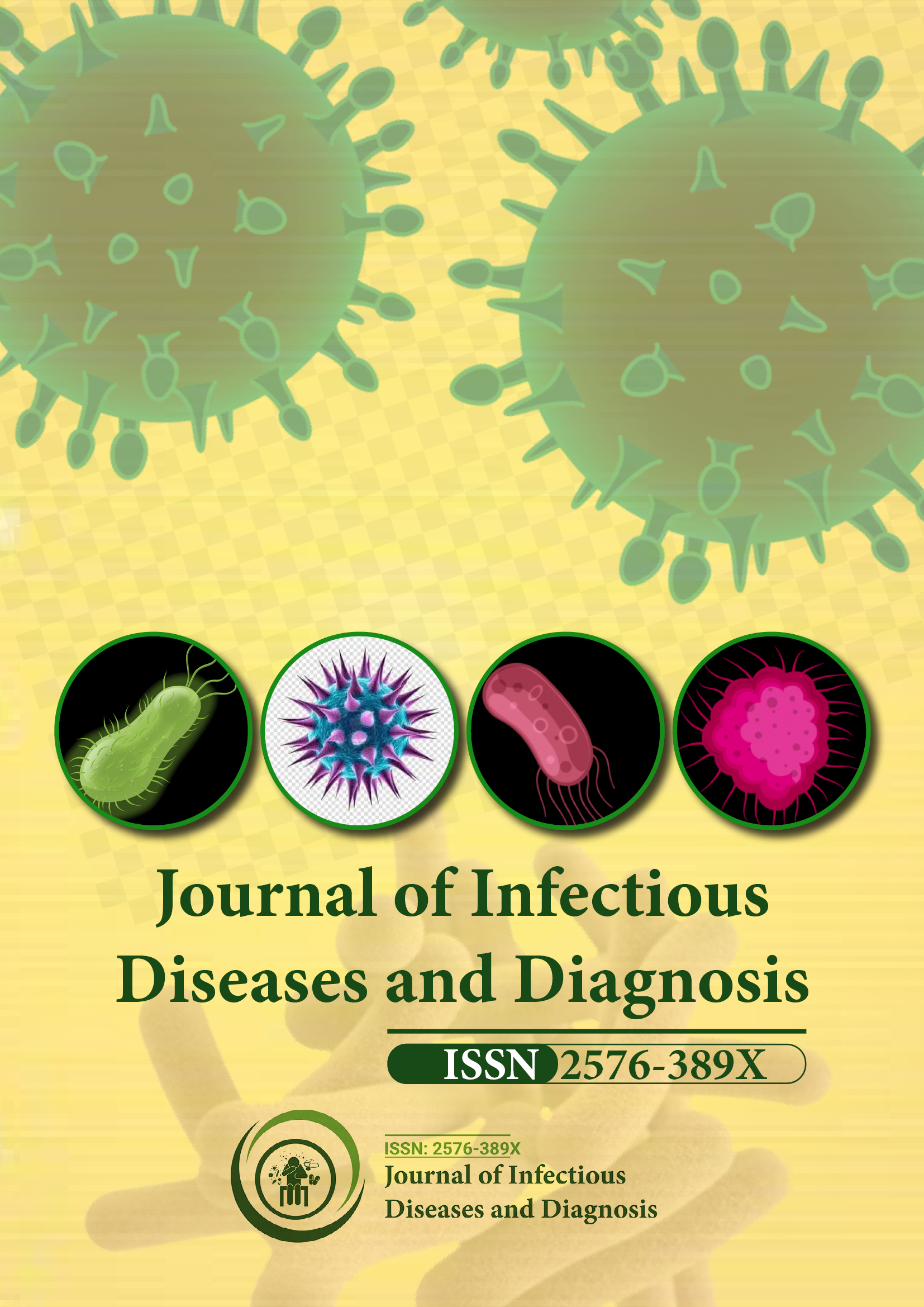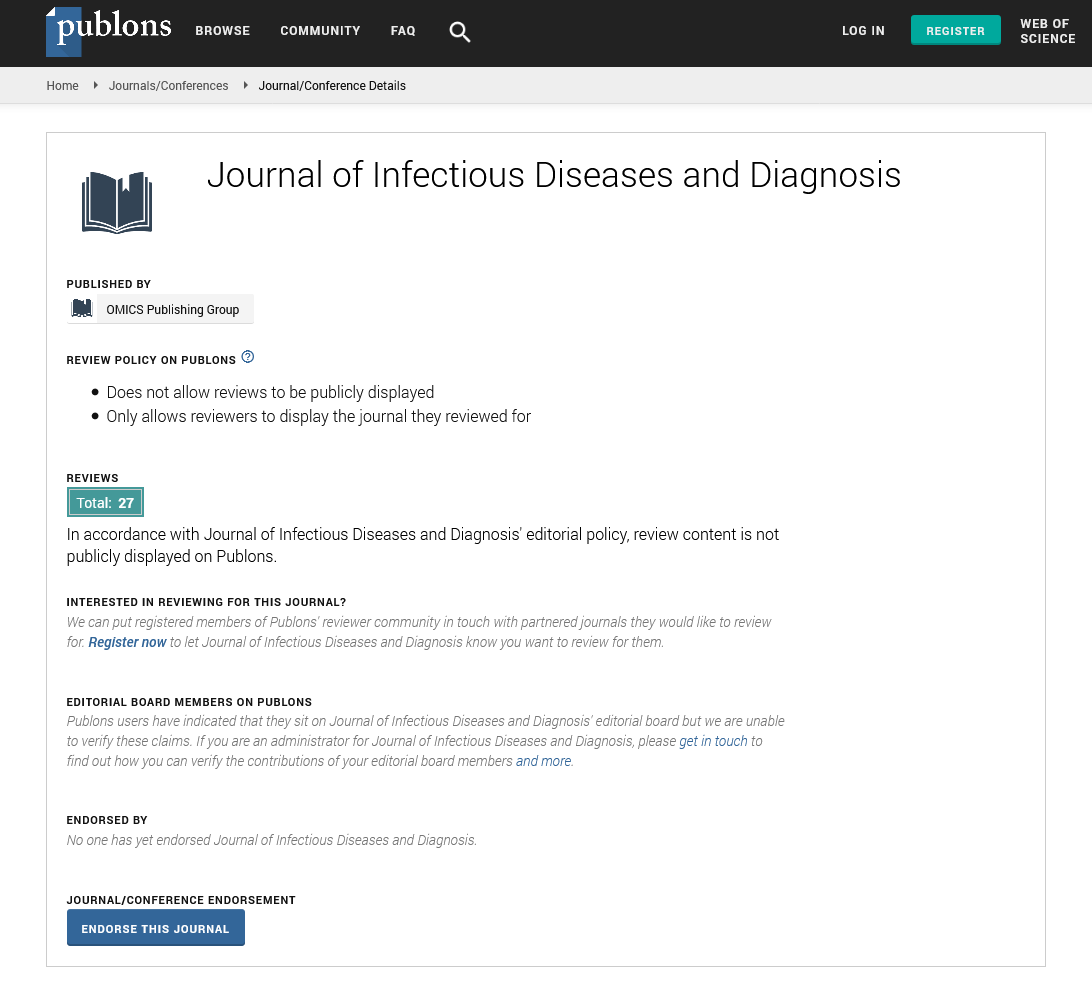Indexed In
- RefSeek
- Hamdard University
- EBSCO A-Z
- Publons
- Euro Pub
- Google Scholar
Useful Links
Share This Page
Journal Flyer

Open Access Journals
- Agri and Aquaculture
- Biochemistry
- Bioinformatics & Systems Biology
- Business & Management
- Chemistry
- Clinical Sciences
- Engineering
- Food & Nutrition
- General Science
- Genetics & Molecular Biology
- Immunology & Microbiology
- Medical Sciences
- Neuroscience & Psychology
- Nursing & Health Care
- Pharmaceutical Sciences
Opinion Article - (2025) Volume 10, Issue 1
Pediatric Infectious Diseases: An Overview of Common Infections, Diagnosis, and Management
Leon Smith*Received: 01-Jan-2025, Manuscript No. JIDD-25-28529; Editor assigned: 03-Jan-2025, Pre QC No. JIDD-25-28529 (PQ); Reviewed: 17-Jan-2025, QC No. JIDD-25-28529; Revised: 24-Jan-2025, Manuscript No. JIDD-25-28529 (R); Published: 31-Jan-2025, DOI: 10.35248/2576-389X.25.10.317
Description
Pediatric infectious diseases remain a major public health concern worldwide, affecting children of all ages. These illnesses can range from mild viral infections to life-threatening bacterial diseases. Early diagnosis and appropriate treatment are essential to prevent complications. Children are highly susceptible to infections due to their developing immune systems and frequent exposure to pathogens in day-care centers, schools and other social settings. Infections in this age group can lead to significant morbidity and, in severe cases, mortality. While many infections are self-limiting, some require medical intervention to prevent long-term consequences. Understanding the nature of pediatric infections, their presentation and the appropriate treatment is essential for healthcare providers, caregivers and public health officials.
Respiratory tract infections
Respiratory infections are among the most frequent illnesses in children. They can be caused by viruses, bacteria or fungi.
Common cold: Caused by rhinoviruses and other respiratory viruses, symptoms include nasal congestion, sneezing, cough and low-grade fever. Supportive care with hydration, rest and symptomatic treatment is usually sufficient.
Influenza: Influenza viruses lead to high fever, muscle aches, cough and fatigue. Annual vaccination is the best preventive measure. Antiviral medications may be prescribed in severe cases.
Pneumonia: A bacterial or viral infection of the lungs, pneumonia presents with fever, difficulty breathing and cough. Bacterial pneumonia, commonly caused by Streptococcus pneumoniae or Haemophilus influenzae, requires antibiotic therapy.
Bronchiolitis: Most often caused by Respiratory Syncytial Virus (RSV), bronchiolitis affects infants, leading to wheezing and respiratory distress. Treatment is supportive, with oxygen therapy in severe cases.
Gastrointestinal infections
Gastrointestinal infections are a major cause of dehydration and malnutrition in young children.
Viral gastroenteritis: Rotavirus and norovirus are leading causes of diarrhea and vomiting. Oral Rehydration Therapy (ORT) is the mainstay of treatment. Vaccination against rotavirus has significantly reduced severe cases.
Bacterial diarrhoea: Escherichia coli, Salmonella and Shigella are common bacterial pathogens causing diarrhea. Antibiotics are used selectively, especially in cases with blood in the stool or systemic illness.
Exanthematous (Rash-causing) diseases
Several viral infections present with skin rashes and systemic symptoms.
Measles: Caused by the measles virus, symptoms include fever, cough, conjunctivitis and a characteristic rash. Vaccination with the Measles-Mumps-Rubella (MMR) vaccine is highly effective in prevention.
Chickenpox: Varicella-zoster virus causes fever and an itchy, vesicular rash. The varicella vaccine has reduced the incidence of this disease.
Hand, Foot and Mouth Disease (HFMD): Coxsackievirus infection leads to fever, mouth ulcers and rashes on the hands and feet. Supportive care is recommended.
Neurological infections
Infections affecting the nervous system can be serious and require urgent medical attention.
Meningitis: Inflammation of the membranes surrounding the brain and spinal cord, caused by bacteria (Neisseria meningitidis, Streptococcus pneumoniae) or viruses. Symptoms include fever, headache, stiff neck and altered consciousness. Bacterial meningitis requires immediate antibiotic treatment.
Encephalitis: Viral infections such as herpes simplex virus can cause brain inflammation, leading to confusion, seizures and weakness. Early antiviral therapy is essential for better outcomes.
Vector-borne diseases
Infections transmitted by insects can affect children, particularly in endemic regions.
Malaria: Caused by Plasmodium species and transmitted by mosquitoes, malaria presents with fever, chills and anemia. Antimalarial medications are necessary for treatment.
Dengue fever: Spread by Aedes mosquitoes, symptoms include high fever, rash and severe body aches. Supportive care with hydration is the primary treatment.
Diagnosis of pediatric infectious diseases
Accurate diagnosis relies on clinical assessment, laboratory tests and imaging studies.
Clinical examination: A thorough history and physical examination help identify patterns of symptoms.
Laboratory tests: Blood tests, cultures and Polymerase Chain Reaction (PCR) help confirm infections.
Imaging studies: Chest X-rays for pneumonia and brain imaging for neurological infections assist in diagnosis.
Management strategies
The treatment of pediatric infections depends on the cause and severity of the illness.
Antibiotics: Used for bacterial infections such as pneumonia, bacterial meningitis and streptococcal throat infections.
Antivirals: Specific antiviral drugs treat conditions like influenza and herpes encephalitis.
Supportive care: Hydration, fever control and oxygen therapy play a key role in managing viral illnesses.
Hospitalization: Severe cases, such as bacterial meningitis or complicated pneumonia, require inpatient care.
Prevention of pediatric infectious diseases
Preventive measures are essential in reducing the burden of infections in children.
Vaccination: Immunization against measles, diphtheria, pertussis, rotavirus and other diseases has significantly reduced infection rates.
Hand hygiene: Regular handwashing with soap prevents transmission of respiratory and gastrointestinal infections.
Breastfeeding: Provides antibodies that protect infants from infections during early life.
Sanitation and safe water: Access to clean water and proper sanitation reduces the risk of diarrheal diseases.
Conclusion
Pediatric infectious diseases continue to pose health challenges, particularly in regions with limited healthcare access. Early recognition, accurate diagnosis and appropriate treatment are necessary to improve outcomes in affected children. Additionally, vaccination and hygiene practices play an important role in preventing the spread of infections. Strengthening public health measures and ensuring timely medical intervention can help reduce the impact of these diseases on children’s health.
Citation: Smith L (2025). Pediatric Infectious Diseases: An Overview of Common Infections, Diagnosis and Management. J Infect Dis Diagn. 10:317.
Copyright: © 2025 Smith L. This is an open-access article distributed under the terms of the Creative Commons Attribution License, which permits unrestricted use, distribution and reproduction in any medium, provided the original author and source are credited.

